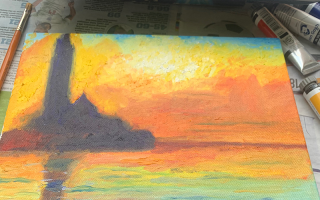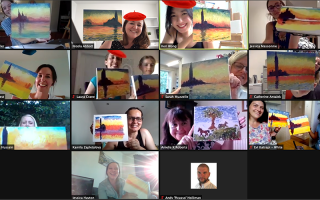Dr Keri Wong (PhD) organised a ‘Whine & Art Happy Hour’ to share her love for oil painting as a means to de-stress with her fellow colleagues in the Department of Psychology and Human Development.
Tell us how you delivered your wellbeing initiative.
The 2-hour session was advertised on Twitter, department listserv and delivered via Zoom primarily to colleagues at the department of Psychology and Human Development (with the exception of 1 sign-up from UCL Social Research Institute). All art supplies were pre-ordered and delivered to participants within 48 hours from Cass Art, a London-based art supply store. Colleagues who already had supplies could still sign-up and join in on the session. The Zoom link was timed to send out via Eventbrite as well as a feedback link following the event.
A total of 14 people joined the session, and we also had a few people signed-up from other institutions too, but I had to clarify to them that the session was only for UCL members of staff. As not everyone knew each other, to start the session, I put the group into smaller breakout rooms for a few minutes to ‘speed meet’ each other, introduce themselves and say why they were interested in joining the event. After this, I put on a 15-minute brief introduction to ‘seeing colour’, getting a baseline of how people felt, before introducing the painting we were going to emulate (Monet’s San Giorgio Maggiore at Dusk). I spent the rest of the time teaching everyone how to paint whilst playing some music in the background.
What was the positive impact of your wellbeing initiative?
The initiative was very well received by the attendees and I was pleased to receive really positive feedback. Everyone said that they enjoyed the event and felt that it helped improve their wellbeing. Some were surprised to find out how much they were able to focus, stay motivated, and not think about anything else during the session. I was also glad to hear that everyone had learnt something new from the event and were keen to do something similar again. My goal for this event was to get people to try painting, enjoy it and perhaps continue it. Now, several months later, I’ve bumped into colleagues ‘in-person’ who reminisce the event and have shown me new paintings they’ve created since. I feel very happy that they’ve found a new hobby to enjoy.
What did you learn from running your wellbeing initiative?
Based on the general feedback for the event, I learned that people were genuinely very grateful that this funding was able to offer them the supplies and experience of trying out something new and creative.
The session duration, 2-hours, was just the right time for the event which involved a mixture of short teaching, mingling and discussion with peers, and conversations that focused on non-COVID/work stress. We got to learn about each other in an informal way. We all connected on the same task. Initially I thought the session may have been too long, but it turned out to be just the right amount of time for everyone to stay focused and complete a small canvas. Some colleagues joined from their offices, abroad too, which I didn’t expect but was happy to see – I suppose this is an advantage of having the session virtually.
Many colleagues spoke about redecorating their office spaces with our paintings now that they have the supplies to do so. We all have a ‘Monet’ hanging somewhere on our walls. Parents on the call also appreciated that the event was child-friendly and open to their children to join in. After the session, one parent decided to use the leftover supplies to teach their little ones how to paint. I was also told that attendees on the call could now ‘teach’ their partners who couldn’t join the event how to paint as they had 2 canvases left and could refer to my introduction to colour theory recording.
In sharing the ‘winners/runners-up’ of the event and getting the department to vote on the paintings they liked (on padlet), I got the whole department involved and people welcomed the good news (on something that was creative and non-work related). The sharing of praises and discovering hidden talents amongst colleagues brought people closer. The virtual recordings also afford the opportunity for other colleagues who couldn’t attend because they were on leave to access and catch-up. Overall, the timing of the event, duration, organisation, and size of the company worked well to create a lovely evening for all attendees.
Top tips for hosting a similar wellbeing initiative?
Ensure that the art supplies reach everyone on-time. This was what I sorted out first. There was no real control over whether people will actually show up on the day e.g., 1 cancelled last minute and received supplies, which meant someone else on the waiting list couldn’t join the session. Luckily this was a small group and I followed up with lots of email communication before and after the event to build rapport with my attendees too. One advantage of putting on the event for the department meant that attendees are very mindful of the resources that can be supplied and others who cancelled last minute already had supplies themselves, so it wasn’t costly to the event.
Use Eventbrite to schedule event sign-ups/email communications – you have the advantage of sending out Zoom invite links securely and timed emails pre-/post-event feedback, so you don’t have to worry about following up once this is set up.
Use padlet to share collage of output – this is a great way to showcase everyone’s finished product. Give it a period of 7 days to 10 days post event for people to finish their artwork as some may not finish during the session. Encourage other people to vote and to leave kind encouraging words to motivate others. Share the link with the community.
Feedback – Use Google Forms to gather quick feedback, both qualitative and quantitative feedback. This can be anonymous and is a better interface than Microsoft Teams. Remember to learn from the feedback too, as this is helpful for organising future events.
Tying the event with a small prize can motivate people too submit their artwork and also feel encouraged to have sustained positive effects post-event. I rewarded some Amazon gift vouchers for the winners and runners-up.
 Close
Close



